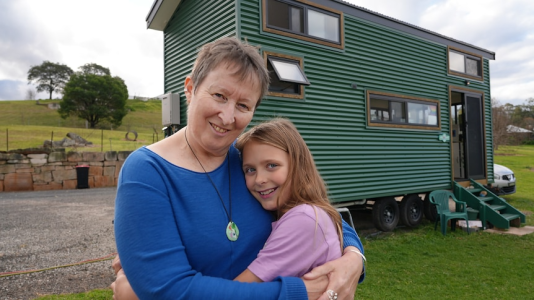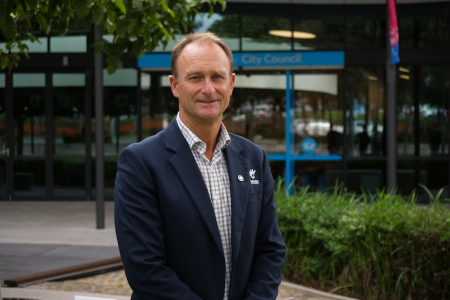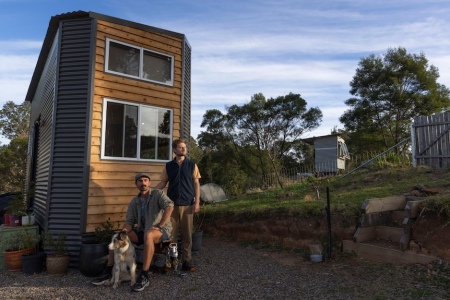Shellharbour Council proposes tiny home planning pathway in NSW first
By
ABC News
- Replies 0
There is hope a trial of new planning rules for mobile tiny homes could become a blueprint for approving the dwellings across New South Wales.
Mobile tiny homes are not clearly defined under state planning laws.
Homes that can be transported on a trailer are typically assessed as caravans and subject to strict conditions, including that they can only be occupied by a member of the primary household.
It is a planning grey area that has left residents across New South Wales struggling to gain approval to live in tiny homes, and councils confused about how to assess them.
Last week, Shellharbour Council approved a proposal to amend its Local Environmental Policy (LEP) for a two-year trial to allow the installation of mobile homes on residential land without a development application.
The changes would remove the condition restricting their occupancy to members of the primary household.
The amendment requires state government approval and a public exhibition period before it is confirmed.
Shellharbour Council's executive director of planning and environment, Michael Park, said he believed it was the first planning pathway of its kind in the state.
"It's an area that creates a lot of confusion for communities and council and industry," he said.
"This is hopefully providing an easy way forward for tiny homes under really certain circumstances."
The policy outlines strict restrictions on eligible structures, including setback requirements, size guidelines and restrictions within bushfire or flood-prone areas.
The tiny home will also need to be on a property with an adjoining approved home and be connected to water and sewer systems.
"That will allow us to keep track and to monitor how many tiny homes we're seeing taken up as part of the trial," Mr Park said.
"It was not about just allowing the types of homes to go anywhere on a site and on any land."
Other NSW councils have called for more clarification around tiny homes and the state government is still considering reforms to the planning legislation for moveable dwellings and caravans.
Shellharbour Mayor Chris Homer, who proposed the trial in 2024, said this could be a solution for them.
"To the best of my knowledge, this is a first for NSW, and my expectation is this mechanism will not only work for Shellharbour, but will also be ready to work for other LGAs [local government areas] should they want to adopt it," he said.
He encountered the complexities of tiny home planning in June, when he received an unexpected eviction notice from his local council, Bega Valley.
The council determined his mobile dwelling, installed on a rural property under an agreement with the landowner, was an "unauthorised structure" requiring development approval, ordering Mr Heins and his partner to vacate.
Mr Heins is fighting the order in the Land and Environment Court and said the definitions set out in the Shellharbour trial provided much-needed "clarity to the community".
"They're obviously trying to address a problem that's pretty widespread in New South Wales and they're taking some concrete steps towards that," he said.
"We need that in Bega Valley because, at the moment, we don't have a consistent or clear definition and that's leading to inconsistent compliance action."
Emily Harrison, Bega Valley Shire's director of community, environment and planning, told the ABC the council would "be watching the Shellharbour trial and progress closely to see what learning and opportunities there are for the Bega Valley Shire".
"It's huge. It's a long time coming," he said.
Mr Duffy said councils struggled to interpret current legislation, leading to a lack of regulation and oversight.
He hoped this could change that.
"Hopefully all the other councils are looking at it and not waiting two years to see if it works or not, just taking a bit of initiative and doing a similar thing," he said.
Written by Penny Burfitt and Isla Evans, ABC News.
Mobile tiny homes are not clearly defined under state planning laws.
Homes that can be transported on a trailer are typically assessed as caravans and subject to strict conditions, including that they can only be occupied by a member of the primary household.
It is a planning grey area that has left residents across New South Wales struggling to gain approval to live in tiny homes, and councils confused about how to assess them.
Last week, Shellharbour Council approved a proposal to amend its Local Environmental Policy (LEP) for a two-year trial to allow the installation of mobile homes on residential land without a development application.
The changes would remove the condition restricting their occupancy to members of the primary household.
The amendment requires state government approval and a public exhibition period before it is confirmed.
Shellharbour Council's executive director of planning and environment, Michael Park, said he believed it was the first planning pathway of its kind in the state.
"It's an area that creates a lot of confusion for communities and council and industry," he said.
"This is hopefully providing an easy way forward for tiny homes under really certain circumstances."
The policy outlines strict restrictions on eligible structures, including setback requirements, size guidelines and restrictions within bushfire or flood-prone areas.
The tiny home will also need to be on a property with an adjoining approved home and be connected to water and sewer systems.
"That will allow us to keep track and to monitor how many tiny homes we're seeing taken up as part of the trial," Mr Park said.
"It was not about just allowing the types of homes to go anywhere on a site and on any land."
Other NSW councils have called for more clarification around tiny homes and the state government is still considering reforms to the planning legislation for moveable dwellings and caravans.
Shellharbour Mayor Chris Homer, who proposed the trial in 2024, said this could be a solution for them.
"To the best of my knowledge, this is a first for NSW, and my expectation is this mechanism will not only work for Shellharbour, but will also be ready to work for other LGAs [local government areas] should they want to adopt it," he said.
Tiny home owners say changes 'needed'
Further down the coast, tiny home owner Joshua Heins hopes his council also adopts the trial.He encountered the complexities of tiny home planning in June, when he received an unexpected eviction notice from his local council, Bega Valley.
The council determined his mobile dwelling, installed on a rural property under an agreement with the landowner, was an "unauthorised structure" requiring development approval, ordering Mr Heins and his partner to vacate.
Mr Heins is fighting the order in the Land and Environment Court and said the definitions set out in the Shellharbour trial provided much-needed "clarity to the community".
"They're obviously trying to address a problem that's pretty widespread in New South Wales and they're taking some concrete steps towards that," he said.
"We need that in Bega Valley because, at the moment, we don't have a consistent or clear definition and that's leading to inconsistent compliance action."
Emily Harrison, Bega Valley Shire's director of community, environment and planning, told the ABC the council would "be watching the Shellharbour trial and progress closely to see what learning and opportunities there are for the Bega Valley Shire".
'Long-time coming'
Australian Tiny House Association NSW branch head Michael Duffy said Shellharbour's proposal outlined a "common sense" planning approach."It's huge. It's a long time coming," he said.
Mr Duffy said councils struggled to interpret current legislation, leading to a lack of regulation and oversight.
He hoped this could change that.
"Hopefully all the other councils are looking at it and not waiting two years to see if it works or not, just taking a bit of initiative and doing a similar thing," he said.
Written by Penny Burfitt and Isla Evans, ABC News.













